At the initiative of FINCANTIERI and convened by Mr. Francesco de Lorenzo, one of the world’s leading experts in Ship Vibrations and Noise, a Technical Seminar on the innovative topic of Radiated Noise in Water by Civilian Ships was held on April 11th in the Italian city of Trieste.
Topics such as noise control were addressed. The technical seminar was attended by major European shipyards such as FINCANTIERI and STX-FRANCE, as well as an expert panel composed of leading Classification Societies: BUREAU VERITAS, LLOYD’s REGISTER, DNV-GL, and RINA, along with the Universities of Genoa, Naples, and Southampton, research centers such as TNO, suppliers like WÄRTSILA, and the Spanish SME TSI-TÉCNICAS Y SERVICIOS DE INGENIERIA, acting as a Vibration and Noise Consultant specializing in the design of “Silent Ships.”
During the Technical Seminar organized in different sessions, the latest experiences and advances in subjects such as noise control were shared. Shipowners and shipyards highlighted their concern for this innovative issue, which classification societies and standardization bodies (ISO and IMO) are beginning to address through the publication of new measurement standards and optional class notations. Additionally, new initiatives by government and public entities are underway to encourage shipowners to reduce the acoustic signature of their vessels.
In this context, the initiative of the port of Vancouver to reduce fees for ships that demonstrate controlled acoustic signatures by obtaining the respective class notation is noteworthy.

TSI, represented by its General Director, Mr. Publio Beltrán, and its Technical Director, Mr. Alfonso Moreno, based on their accumulated experience in participating in European Projects BESST, SILENV, and AQUO, presented the methodology that TSI has been using for over thirty years to assist Shipowners and Shipyards in the design of “Silent Ships” in compliance with class notations and regulations related to radiated noise in water by ships. During this session, a series of success cases of ships with BUREAU VERITAS URN-614 class notations were presented.
As conclusions from the Seminar, some highlighted points include:
- The need for harmonization and standardization of current measurement procedures, both in deep and shallow waters, as well as the Radiated Noise in Water limits for different types of ships.
- The advisability of having Fishing and Oceanographic Research Vessels, as “technological benchmarks” for the civilian ship segment must comply with ICES CRR report 209, certified by an “independent third party.”
- The importance of the “validation of the effectiveness of the different tested methodologies” as a prior and indispensable step for the generation of “Design Guides” applicable to the Maritime Sector.
- The dual role of Classification Societies as Certifiers and Consultants simultaneously does not contribute to the transparency of this market.
Finally, the fact that a shipyard like FINCANTIERI, which currently leads the construction of Cruise Ships worldwide, motivates or promotes seminars on noise control, reveals a clear awareness and commitment of the Global Maritime Sector to the significant challenge of Reducing Radiated Noise in Water by Ships and its impact on marine fauna and ecosystems.

